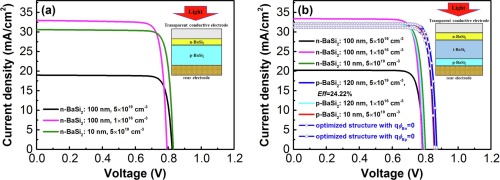当前位置:
X-MOL 学术
›
Sol. Energy
›
论文详情
Our official English website, www.x-mol.net, welcomes your
feedback! (Note: you will need to create a separate account there.)
Theoretical analysis of doping concentration, layer thickness and barrier height effects on BaSi2 based homojunction solar cells toward high efficiency
Solar Energy ( IF 6.0 ) Pub Date : 2020-05-01 , DOI: 10.1016/j.solener.2020.03.056 Hui Liao , Quanrong Deng , Yonglong Shen , Geming Wang , Shenggao Wang , Yangwu Mao
Solar Energy ( IF 6.0 ) Pub Date : 2020-05-01 , DOI: 10.1016/j.solener.2020.03.056 Hui Liao , Quanrong Deng , Yonglong Shen , Geming Wang , Shenggao Wang , Yangwu Mao

|
Abstract Numerical calculation and theoretical study on high optical absorption material BaSi2 based np or nip homojunction solar cells were conducted by using AMPS software. The effects of doping concentration and front layer thickness on the performance of n-BaSi2/p-BaSi2 homojunciton solar cell were comprehensive investigated. It was found that the donor concentration and thickness of n-BaSi2 had decisive influence on the light performance of n-BaSi2/p-BaSi2 homojunciton solar cell, since high donor concentration in n-BaSi2 gave rise to extremely high hole trapping concentration in n-BaSi2 and thus reduced the hole current as well as total current density under light illumination. Consequently, the n-BaSi2 layer was suggested to be designed either with low donor concentration or with thin thickness to achieve high power conversion efficiency. Same effect of n-BaSi2 on the performance of nip homojucntion solar cell was also observed. Contrarily, the optimized p-BaSi2 was suggested to possess high acceptor concentration and to be slightly thicker, in order to maintain the high built-in potential as well as Voc of nip homojunciton solar cell. On account of the front and rear contact barrier height between electrode and BaSi2 functional layer, the barrier height between p-BaSi2 and rear contact electrode had comparably more sensitive influence to attenuate the built-in potential and thus the Voc of BaSi2 based nip the solar cell. However, this negative influence caused by high barrier height could be convincingly conquered by employing thick p-BaSi2 layer.
中文翻译:

掺杂浓度、层厚和势垒高度对 BaSi2 基同质结太阳能电池高效化的理论分析
摘要 利用AMPS软件对高吸光材料BaSi2基np或nip同质结太阳能电池进行了数值计算和理论研究。综合研究了掺杂浓度和前层厚度对n-BaSi2/p-BaSi2同质结太阳能电池性能的影响。研究发现,n-BaSi2 的施主浓度和厚度对 n-BaSi2/p-BaSi2 同质结太阳能电池的光性能有决定性影响,因为 n-BaSi2 中的高施主浓度会导致 n-BaSi2 中极高的空穴捕获浓度。 -BaSi2 从而降低了光照射下的空穴电流和总电流密度。因此,建议将 n-BaSi2 层设计为具有低施主浓度或薄厚度,以实现高功率转换效率。还观察到 n-BaSi2 对 nip 同质结太阳能电池性能的相同影响。相反,建议优化的 p-BaSi2 具有高受体浓度和稍厚,以保持 nip 同质结太阳能电池的高内置电位和 Voc。由于电极和 BaSi2 功能层之间的前后接触势垒高度,p-BaSi2 和后接触电极之间的势垒高度对衰减内置电位的影响相对更敏感,因此基于 BaSi2 的 Voc 抑制太阳能细胞。然而,通过采用厚 p-BaSi2 层可以令人信服地克服由高势垒高度引起的这种负面影响。建议优化的 p-BaSi2 具有高受主浓度和稍厚,以保持 nip 同质结太阳能电池的高内置电位和 Voc。由于电极和 BaSi2 功能层之间的前后接触势垒高度,p-BaSi2 和后接触电极之间的势垒高度对衰减内置电位的影响相对更敏感,因此基于 BaSi2 的 Voc 抑制太阳能细胞。然而,通过采用厚 p-BaSi2 层可以令人信服地克服由高势垒高度引起的这种负面影响。建议优化的 p-BaSi2 具有高受主浓度和稍厚,以保持 nip 同质结太阳能电池的高内置电位和 Voc。由于电极和 BaSi2 功能层之间的前后接触势垒高度,p-BaSi2 和后接触电极之间的势垒高度对衰减内置电位的影响相对更敏感,因此基于 BaSi2 的 Voc 抑制太阳能细胞。然而,通过采用厚 p-BaSi2 层可以令人信服地克服由高势垒高度引起的这种负面影响。由于电极和 BaSi2 功能层之间的前后接触势垒高度,p-BaSi2 和后接触电极之间的势垒高度对衰减内置电位的影响相对更敏感,因此基于 BaSi2 的 Voc 抑制太阳能细胞。然而,通过采用厚 p-BaSi2 层可以令人信服地克服由高势垒高度引起的这种负面影响。由于电极和 BaSi2 功能层之间的前后接触势垒高度,p-BaSi2 和后接触电极之间的势垒高度对衰减内置电位的影响相对更敏感,因此基于 BaSi2 的 Voc 抑制太阳能细胞。然而,通过采用厚 p-BaSi2 层可以令人信服地克服由高势垒高度引起的这种负面影响。
更新日期:2020-05-01
中文翻译:

掺杂浓度、层厚和势垒高度对 BaSi2 基同质结太阳能电池高效化的理论分析
摘要 利用AMPS软件对高吸光材料BaSi2基np或nip同质结太阳能电池进行了数值计算和理论研究。综合研究了掺杂浓度和前层厚度对n-BaSi2/p-BaSi2同质结太阳能电池性能的影响。研究发现,n-BaSi2 的施主浓度和厚度对 n-BaSi2/p-BaSi2 同质结太阳能电池的光性能有决定性影响,因为 n-BaSi2 中的高施主浓度会导致 n-BaSi2 中极高的空穴捕获浓度。 -BaSi2 从而降低了光照射下的空穴电流和总电流密度。因此,建议将 n-BaSi2 层设计为具有低施主浓度或薄厚度,以实现高功率转换效率。还观察到 n-BaSi2 对 nip 同质结太阳能电池性能的相同影响。相反,建议优化的 p-BaSi2 具有高受体浓度和稍厚,以保持 nip 同质结太阳能电池的高内置电位和 Voc。由于电极和 BaSi2 功能层之间的前后接触势垒高度,p-BaSi2 和后接触电极之间的势垒高度对衰减内置电位的影响相对更敏感,因此基于 BaSi2 的 Voc 抑制太阳能细胞。然而,通过采用厚 p-BaSi2 层可以令人信服地克服由高势垒高度引起的这种负面影响。建议优化的 p-BaSi2 具有高受主浓度和稍厚,以保持 nip 同质结太阳能电池的高内置电位和 Voc。由于电极和 BaSi2 功能层之间的前后接触势垒高度,p-BaSi2 和后接触电极之间的势垒高度对衰减内置电位的影响相对更敏感,因此基于 BaSi2 的 Voc 抑制太阳能细胞。然而,通过采用厚 p-BaSi2 层可以令人信服地克服由高势垒高度引起的这种负面影响。建议优化的 p-BaSi2 具有高受主浓度和稍厚,以保持 nip 同质结太阳能电池的高内置电位和 Voc。由于电极和 BaSi2 功能层之间的前后接触势垒高度,p-BaSi2 和后接触电极之间的势垒高度对衰减内置电位的影响相对更敏感,因此基于 BaSi2 的 Voc 抑制太阳能细胞。然而,通过采用厚 p-BaSi2 层可以令人信服地克服由高势垒高度引起的这种负面影响。由于电极和 BaSi2 功能层之间的前后接触势垒高度,p-BaSi2 和后接触电极之间的势垒高度对衰减内置电位的影响相对更敏感,因此基于 BaSi2 的 Voc 抑制太阳能细胞。然而,通过采用厚 p-BaSi2 层可以令人信服地克服由高势垒高度引起的这种负面影响。由于电极和 BaSi2 功能层之间的前后接触势垒高度,p-BaSi2 和后接触电极之间的势垒高度对衰减内置电位的影响相对更敏感,因此基于 BaSi2 的 Voc 抑制太阳能细胞。然而,通过采用厚 p-BaSi2 层可以令人信服地克服由高势垒高度引起的这种负面影响。







































 京公网安备 11010802027423号
京公网安备 11010802027423号